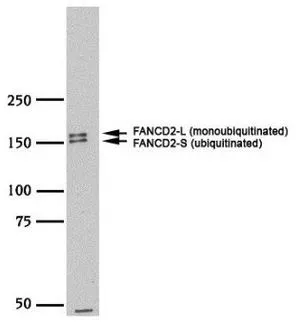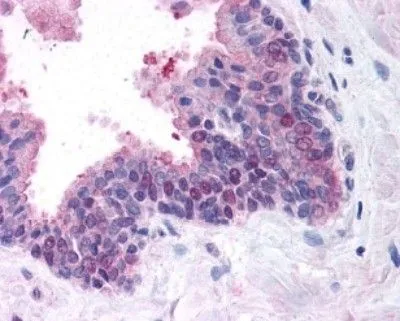
GTX30142 WB Image
FANCD2 antibody

GTX30142
ApplicationsFlow Cytometry, ImmunoPrecipitation, Western Blot, ImmunoHistoChemistry, ImmunoHistoChemistry Paraffin
Product group Antibodies
ReactivityCanine, Human, Mouse, Primate
Overview
- SupplierGeneTex
- Product NameFANCD2 antibody
- Delivery Days Customer10
- ApplicationsFlow Cytometry, ImmunoPrecipitation, Western Blot, ImmunoHistoChemistry, ImmunoHistoChemistry Paraffin
- CertificationResearch Use Only
- ClonalityPolyclonal
- Concentration1 mg/ml
- HostRabbit
- IsotypeIgG
- Scientific DescriptionThe Fanconi anemia complementation group (FANC) currently includes FANCA, FANCB, FANCC, FANCD1 (also called BRCA2), FANCD2, FANCE, FANCF, FANCG, FANCI, FANCJ (also called BRIP1), FANCL, FANCM and FANCN (also called PALB2). The previously defined group FANCH is the same as FANCA. Fanconi anemia is a genetically heterogeneous recessive disorder characterized by cytogenetic instability, hypersensitivity to DNA crosslinking agents, increased chromosomal breakage, and defective DNA repair. The members of the Fanconi anemia complementation group do not share sequence similarity; they are related by their assembly into a common nuclear protein complex. This gene encodes the protein for complementation group D2. This protein is monoubiquinated in response to DNA damage, resulting in its localization to nuclear foci with other proteins (BRCA1 AND BRCA2) involved in homology-directed DNA repair. Alternative splicing results in two transcript variants encoding different isoforms. [provided by RefSeq]
- ReactivityCanine, Human, Mouse, Primate
- Storage Instruction2°C to 8°C,-20°C
- UNSPSC12352203
References
- Cisplatin-induced DNA damage activates replication checkpoint signaling components that differentially affect tumor cell survival. Wagner JM et al., 2009 Jul, Mol PharmacolRead more
- Diagnosis of Fanconi anemia in children with atypical clinical features: a primary study. Liu R et al., 2013 Dec, Chin Med J (Engl)Read more
- Differential roles for DNA polymerases eta, zeta, and REV1 in lesion bypass of intrastrand versus interstrand DNA cross-links. Hicks JK et al., 2010 Mar, Mol Cell BiolRead more
- Genomically Incorporated 5-Fluorouracil that Escapes UNG-Initiated Base Excision Repair Blocks DNA Replication and Activates Homologous Recombination. Huehls AM et al., 2016 Jan, Mol PharmacolRead more
- Homologous recombination is a primary pathway to repair DNA double-strand breaks generated during DNA rereplication. Truong LN et al., 2014 Oct 17, J Biol ChemRead more
- HPV-16 E7 reveals a link between DNA replication stress, fanconi anemia D2 protein, and alternative lengthening of telomere-associated promyelocytic leukemia bodies. Spardy N et al., 2008 Dec 1, Cancer ResRead more
- Multiple DNA damage signaling and repair pathways deregulated by simian virus 40 large T antigen. Boichuk S et al., 2010 Aug, J VirolRead more
- RAD18-mediated ubiquitination of PCNA activates the Fanconi anemia DNA repair network. Geng L et al., 2010 Oct 18, J Cell BiolRead more
- The BRCA1-interacting protein Abraxas is required for genomic stability and tumor suppression. Castillo A et al., 2014 Aug 7, Cell RepRead more
- The human papillomavirus type 16 E7 oncoprotein activates the Fanconi anemia (FA) pathway and causes accelerated chromosomal instability in FA cells. Spardy N et al., 2007 Dec, J VirolRead more


